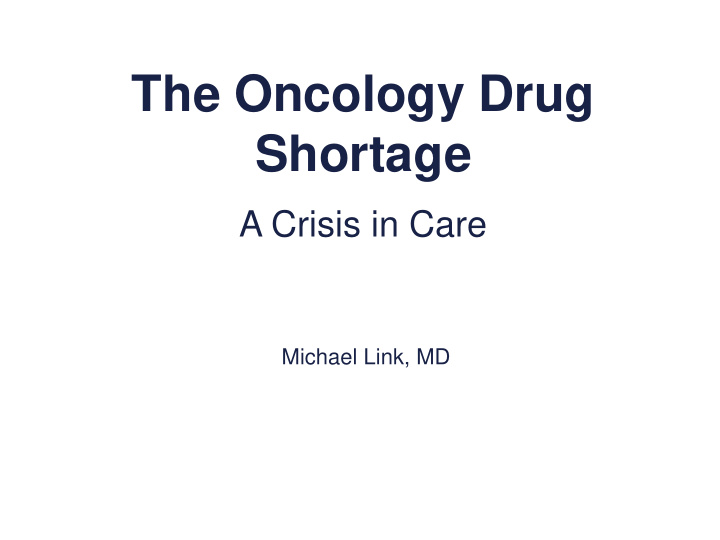



The Oncology Drug Shortage A Crisis in Care Michael Link, MD
Historical Drug Shortage Data 120 100 ASHP DS WRC launched 80 60 40 20 0 1996 1997 1998 1999 2000 2001 2002 Univ of Utah DIS National
Annual New Drug Shortages January 2001 to December 31, 2010 250 211 Tripled since 2006 200 166 149 150 129 100 73 74 70 58 50 0 03 04 05 06 07 08 09 10 University of Utah Drug Information Service
National Drug Shortages January 2001 to June 20, 2011 250 211 200 149 166 156 150 129 120 Shortages 88 100 58 74 73 70 50 0 01 02 03 04 05 06 07 08 09 10 11 Note: Each column represents the # of new shortages identified during that year Source: University of Utah Drug Information Service
Shortages by Drug Class > 10 Shortages in 2010 Shortages 28 30 25 20 19 17 20 14 13 13 15 11 10 Shortages 5 0
Shortages by Drug Class 60 50 16 40 30 11 8 3 20 8 2011 YTD 6 7 34 2 23 23 23 2010 10 15 15 14 13 0
Comparing drug shortage trends Then and now… • 1996 - 2003 – Average # of drugs tracked: 60/year • 2003 – 2011 – Average # of drugs tracked: 150/year
Crisis • Current pace is for >300 for 2011 – Q1 2010 = 49 shortages vs. Q1 2011= 89 – Jan 1, 2011 through June 20, 2011 = 156 • Particularly concerning for oncology: 77% of 2010 shortages were of sterile injectables • Chemotherapy drug shortages – 23 in 2010 and 11 so far in 2011 (Q1) – No alternatives to these drugs for most indications • Manufacturing issues are not resolving
Causes of the Drug Shortage • Manufacturing difficulties/compliance issues • Corporate decisions/discontinuations • Market concentration/limited capacity • Raw materials/API shortage • Changes in clinical practice • Emergency situations • Hospital/pharmacy-based issues *Source: FDA November 2010
Causes of Drug Shortages 2010 Discontinued 7% No reason provided 47% Manufacturing Raw Materials 28% 3% Supply/ Demand 14% Regulatory 1% Source: University of Utah DIS
Shortages of Sterile Injectables: Marketing/Business Causes For older sterile injectable products – Fewer firms making these products – Not enough capacity – Complex manufacturing process – Generally not economically attractive; not enough financial return to justify corrective action when problem occurs – Resources directed to more profitable products When one firm has problems or discontinues, a shortage almost always occurs.
Oncology Drugs in Short Supply DRUG APPLICATION Bleomycin Lymphoma, testis Busulfan Bone marrow transplantation Cisplatin Testis, ovary, lung, sarcoma Cytarabine Leukemia, lymphoma Daunomycin Leukemia, lymphoma Doxorubicin Leukemia, lymphoma, breast, sarcoma Etoposide Leukemia, sarcoma, testis, lung Leucovorin Bowel, sarcoma. lymphoma Mechlorethamine Lymphoma Methotrexate Leukemia, lymphoma Taxol Breast, lung Thiotepa Bone marrow transplantation Vincristine Many cancers
Consequences of Cancer Drug Shortage • Treatment delays — never a good idea • Substitution treatments – Less effective therapies – Sometimes no effective work-around available • Increased patient anxiety • Time and expense of finding drug supply • Adverse effect on ongoing clinical trials • Price markup and increase costs of care
Consequences of Cancer Drug Shortage • Unavailability of Potentially Curative Therapy – Leukemia – Hodgkin disease – Non-Hodgkin lymphoma – Testis cancer – Sarcomas of bone and soft tissue – Multiple childhood cancers
Survival Trends in Common Pediatric Cancers 100 Hodgkin Lymphoma Wilms tumor ALL 80 Non-Hodgkin lymphoma Brain tumors Neuroblastoma Bone tumors 60 AML 5 Yr Survival [%] 40 20 0 1960-63 1970-73 1974-76 1977-79 1980-82 1983-85 1986-88 1989-91 1992-97
Improvement in Outcome Over Time: Results of COG Studies of ALL 100 1996-2000 (n=3421) 1989-1995 (n=5121) 80 1983-1988 (n=3711) 60 1978-1983 (n=2984) 1975-1977 (n=1313) 40 1972-1975 (n=936) 1970-1972 20 (n=499) 1968-1970 (n=402) 0 0 2 4 6 8 10 12 14 16 18
Consequences of Cancer Drug Shortage — Childhood Leukemia • Acute Lymphoblastic Leukemia (ALL) – Most common childhood cancer – 5000 cases annually in the USA – Currently ~ 85-90% are cured • Curative therapy for ALL Vincristine* Mercaptopurine (pills) Prednisone (pills) Cyclophosphamide Asparaginase Cytarabine* Daunomycin* Methotrexate* + leucovorin* *In short supply
Consequences of Cancer Drug Shortage — Bone Tumors • Osteosarcoma – Most common bone tumor in children and adolescents – Currently 65% can be cured with surgery + chemotherapy – <10% cured with surgery but without chemotherapy • Curative therapy for osteosarcoma Surgery Doxorubicin* Cisplatin* High dose methotrexate* + leucovorin* *In short supply
Recommend
More recommend